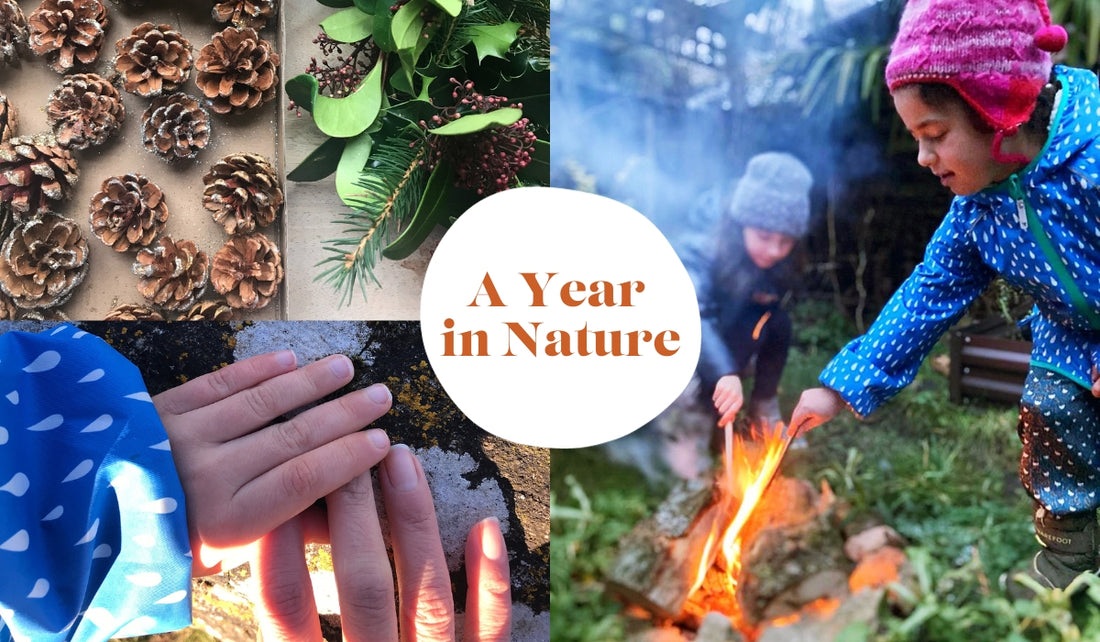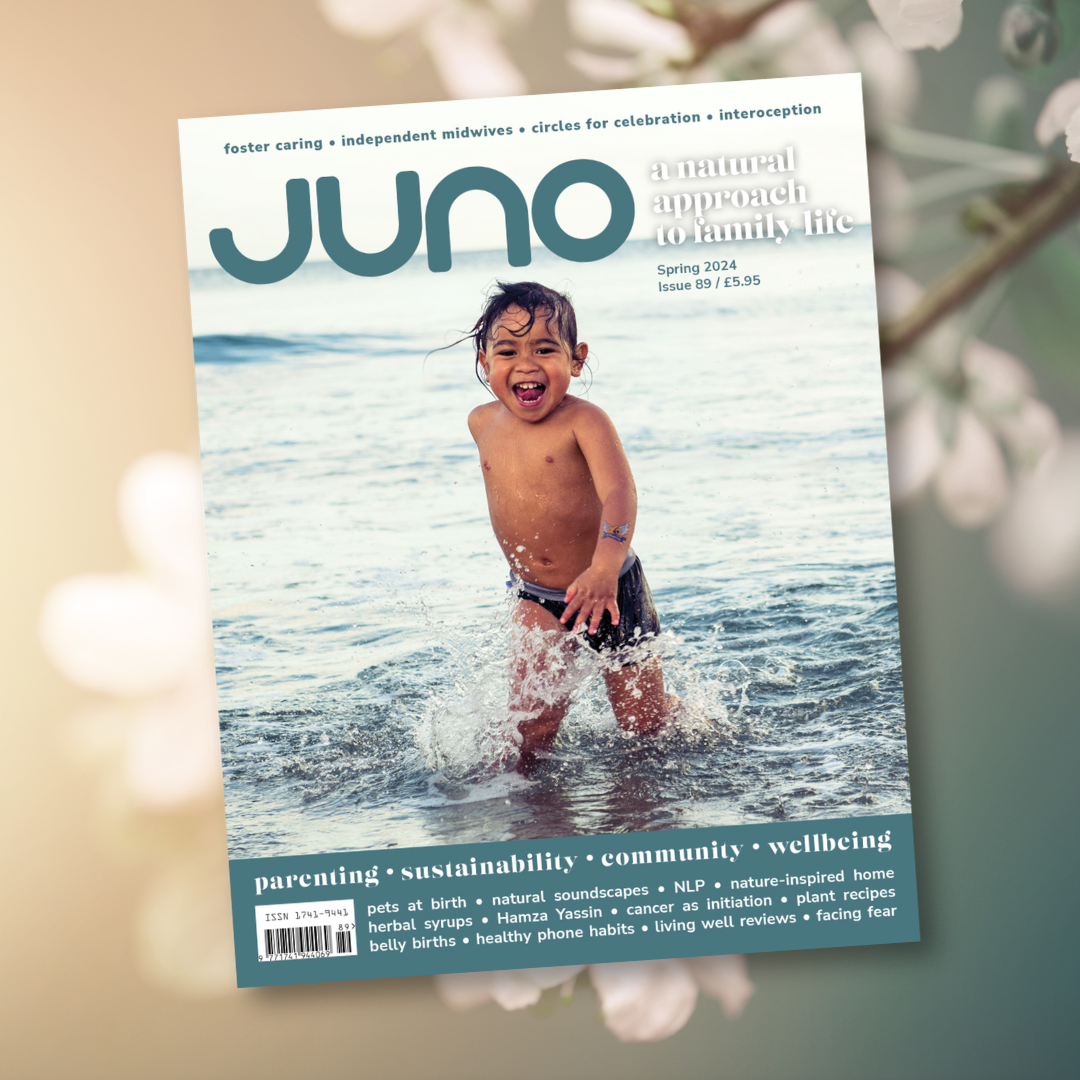With the arrival of winter, Emine Kali Rushton hankers for fire, circles and cocoa...
It’s the strangest thing: since life ‘returned to normal’ (“Ha!” my spirit cries, “Who are you kidding?”), and the pace of the everyday picked up, winter arrives in my home not with a sense of dread, but absolute surrender and, if I am honest, quite a bit of relief too.
We’re no longer expected to be ‘out’ all the time. This is the season when it feels as though I am granted permission to burrow under blankets with books, drink hot cocoa every night, go up for an extra-early night of nesting and resting (the earlier darkening a gift to anyone feeling depleted) and take as many rain checks as I like – choosing instead a family movie afternoon with cinnamon-and-sea-salt popcorn and a heavy duvet, the ideal rainy-day antidote to the week’s busyness and movement.
My husband rises a little before the rest of us to fire up the log burner and get the front of the house toasty before school and work. There’s no denying that waking in darkness is a hardship at this time of year, but it comes with an opportunity to invite in the light, and gathering for breakfast with a lit candle in the table’s centre and a fire roaring and crackling lifts the spirit no end.
A comforting cloak
Winter’s weight can feel too much at times, yes, but it can also be the comforting cloak we all need at the end of another tumultuous, turbulent, challenging year. For many of us, it is in winter that work reaches its natural (if temporary) conclusion. We may have some time away from our jobs, children are home for the holidays and our lives are no longer drawn outward under the sky and sun, but rather inward, to the hearth, home and heart.
But it is also a time for gathering with those we love most in the world. We may seek out local festive fairs and festivals that invite light into the darkness, and perhaps even attend carol services or Christmas plays or pantomimes. The festive season – whatever it looks like for us – has a wonderful way of reuniting us with our wider circles and communities. Warmth, sweetness, goodness – there’s more of it this season. Our spirits remain plump and nourished.
All hibernating animals in nature must put on their winter coats and replenish their fat stores. Our sweet little rabbit, Pip, is twice the size now – a plump puffball of softest amber fur – as he readies himself for winter’s advent. And though we may not want to pad ourselves up in quite the same way, the notion and natural impetus is just the same.
Winter nourishment
Often, from autumn onwards, my cravings shift. The need for carbohydrates – sweet root veg, bread, pasta, rice, baked goods – rises. We think of these things as comfort food, and they are, and were always meant to be. Emma Mitchell, the wonderful author of The Wild Remedy, who has struggled with depression for over two decades, celebrates the ability of baking to bring cheer to chilly moods and icy days. And because carbohydrates are essential in supporting us to produce serotonin, the ‘happy hormone’ that is depleted in winter, there is just cause to celebrate a bevy of carbrich dishes and feed those primal, natural and helpful cravings.
From roasted sweet potatoes piled high with garlicky hummus and herby beans, to root veg soups laced with chilli, I try to balance warmth and sweetness with some bitter, pungent and astringent flavours, which in Ayurveda are very helpful for counterbalancing damp and cold. Try adding spice to bitter veg (think kale or broccoli tossed with garlic and chilli) or making deep, green soups from seasonal greens, drizzled with olive oil and sprinkled with nutmeg. Pen the recipes you enjoy into your nature journal with a small photo or a line to jog the memory as to why it was such a good meal (“The children had thirds!”) and return to it next winter for warming inspiration.
We also know that exposure to sunlight increases serotonin production, so ensuring that we absorb as much of it as we can while it is available – by wrapping up warm on a frightfully cold but beautifully bright winter’s day and heading out for a long walk, letting winter’s light pour into our eyes and catch our faces – is winter’s best medicine. Finding and foraging some winter wonders that can go into your nature journal or be made into winter elixirs (see the elderberry recipe) will keep the children purposeful and positive – just so long as there’s a promise of something warm and delicious at the end, of course.
In our wee cottage, the old gas oven works overtime now – baking and making – as we feed the brood with curries, soups, stews and hotpots, and conjure creations to gift to friends, family and neighbours at the year’s end: gingerbread, spiced chocolate, ginger beer.
Books play a big part in our lives at Christmas too. We buy one truly special book for one another to share on Christmas Eve, an Icelandic tradition that we’ve happily adopted, and which has become a cornerstone of our nesting and resting season. I love being gifted this time, and though I also love seeing friends and family, I endeavour to stay firm-ish with myself, and avoid the temptation to see a holiday from work as an opportunity to get everything else DONE.
Celebrate winter’s darkness with a seasonal remedy and a warming ritual
Fire Stories
A happy habit we’ve picked up from summer festivals is as simple as it gets – gathering around the firepit in the garden to share stories. When the mercury dips, we layer on fleece-lined coats, hats and boots, and head out into the garden as the moon begins to make an appearance, marshmallows, cocoa and long toasting sticks obligatory. Our girls often retell the tales learned by heart from renowned storyteller Ian Douglas (their favourites are the tales of ‘horrible aunty’ and Finn McCool, which they enjoy every single year at Just So Festival in Cheshire), or choose a poem, passage or story from a favourite book to read across the flames.
Elderberry Elixir with Spice and Thyme
This is a staple within our natural medicine cabinet. The girls take a small spoonful throughout late autumn and winter, and we also make hot toddies with it (although we let it cool if we are going to add raw honey to it ), which the girls drink diluted throughout the day. It’s a bit like the Ribena my mum used to give me as a child, but a whole lot better for your beautiful body.
- Be sure to identify very carefully and accurately when gathering wild food.
- Choose elderberries hanging away from roadsides or polluted areas, deep, dark and rich in colour. Do not harvest green, pale red or pink-hued elderberries.
- Gather a bagful, chosen from many different trees and leaving plenty for all other beings and the natural balance of the space.
- Rinse your elderberries well and strip from the stalks into a saucepan. Add a couple of sprigs of fresh thyme, a chunk of grated fresh ginger, 4 cloves, 2 star anise, 2 cinnamon sticks and 4 cardamom pods, the latter crushed a little to release the flavour.
- Cover with water, bring to a low boil and allow to simmer for 20 minutes, stirring and muddling mindfully until your liquor is richly coloured and scented.
- Strain the liquor through muslin or cheesecloth into a measuring jug and measure the amount that you have.
- Return to a saucepan and add just a little less than the same quantity of organic, unrefined sugar. So, if you have 500ml of liquor, add around 450g of sugar. We often use jaggery as our sugar of choice and the reason we don’t use honey is because in Ayurveda, when honey is heated, it is deemed toxic to the bodily systems. But, if you did want to use honey, you could add it to the liquor once it cools down, and then stir away from heat until dissolved.
- If using sugar, simmer and stir for a further 10 minutes to allow it to fully dissolve.
- Transfer to sterilised bottles and store in a cool, dark place.
This year, Emine Kali Rushton has invited us to create a nature journal alongside her. A place to keep track of the things we see, learn, try and experience, in whatever form we find most pleasing – photos, sketches, rubbings, pressings, recipes, poems, notes, stories. At the year’s end, we have a beautiful book of memories, as well as seasonal inspiration to return to over and over again.
____
Emine Kali Rushton is a writer and author, whose books include Natural Wellness Every Day: The Weleda Way and Sattva: The Ayurvedic Way to Live Well. She runs a seasonal self-care membership for women from her cottage in Kent, and also makes seasonal wild remedies from her garden. thisconsciousbeing.com and on Instagram @eminekalirushton
____
Published in issue 81 of JUNO. Accurate at the time this issue went to print.



